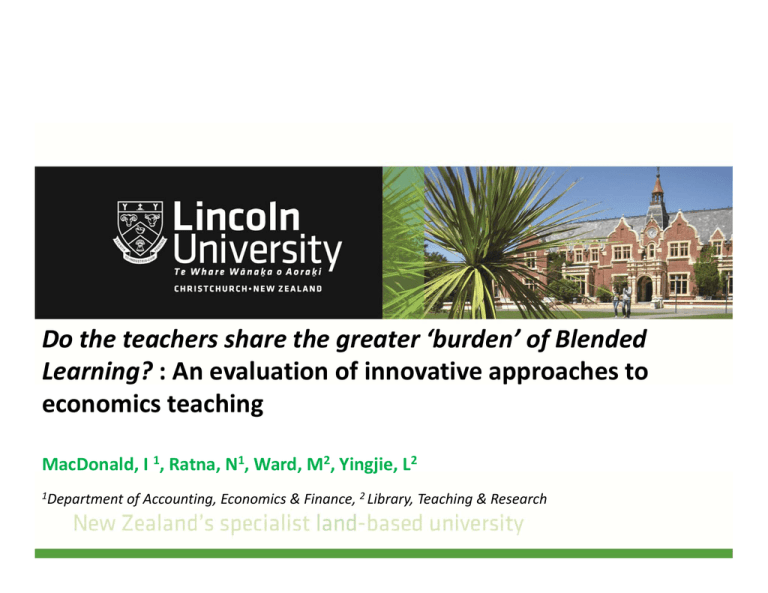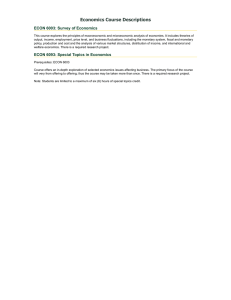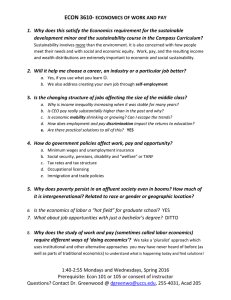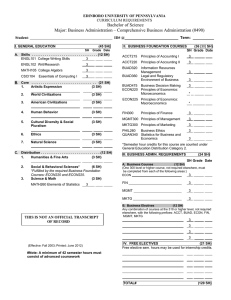Do the teachers share the greater ‘burden’ of Blended Learning? economics teaching MacDonald, I
advertisement

Do the teachers share the greater ‘burden’ of Blended Learning? : An evaluation of innovative approaches to economics teaching
MacDonald, I 1, Ratna, N1, Ward, M2, Yingjie, L2
1Department of Accounting, Economics & Finance, 2 Library, Teaching & Research
Motivation: Blended learning and Cost‐Benefit Analysis ( CBA)
• Why did we opt for looking at CBA of adoption? • Who are the stakeholders? – Teachers
– Students ‐University Administration • Why Economics courses at Lincoln University?
– ECON 215: Managerial Economics
– ECON 603: Development Economics What are the drivers of adoption? • Rogers ( 1962, 2003): Social Networks & Diffusion of Innovations – innovators
– early adopters
– early majority
– late majority
– Laggards
Adoption of Technology in Teaching • Finely & Hartman (2004): Western Michigan University Pedagogical concerns, skills, departmental culture • Birch & Barret (2009): University of Southern Queensland – Institutional Barriers : absence of program‐wide strategic plan and specialised training
– Individual barriers: workload, lack of reward & recognition • Orr et. al.( 2009): University of North Carolina – Availability of Compensation( stipend, course release time, summer development activities) is not an essential motivator
Technology and ‘Incentives’ for Teachers(?) • Complementarity vs. Substitutability
• Rationality: Is iT better for my students? • Compatibility: Do I have enough skills/ knowledge to adopt iT? • Complexity: Is iT user friendly? • Measurability: Can we test and observe iT
working? What is Blended Learning at LU?
• Blended learning is learning that is facilitated by the effective combination of different modes of delivery, models of teaching and styles of learning…
– Heinze, A.; C. Procter (2004)
• It is not an attempt at distance learning by stealth or even a first step in that direction
• Technology is a tool... not a means‐to‐an‐end
Ian Mac Donald & Maurice Ward:Flexible Learning
Case Study 1 : Managerial Economics
ECON 215
• Complementarity: f2f and online learning
• Rationality: creating personal learning space
• Tools – Pre‐module concept and skill check
– Review Quizzes
– Lectorials
– Practice quizzes
– Interactive lessons
f.WI Lincoln
A standard module for ECON 215
~ University
To .... ~." W ~nQ ~ • • A ". ~ I
<H.' i ' CHU.'"· . . . . . . M A" 0
o.
"
Cou"," ECONZl5 - Ml n.og"''' ' Econom,,,1012 - Window<lnt.m<t h plo,., p,ovidod by lincoln Un ..... "ity
'i/ir f .... o,~..
!:::2
http://lelI rn , li rKol n ,K , ''''lelIm/(ou =lvi~, php?id
I~ (ou,"',
ECONZl5 - ""''''' 9.,,,,1 [(000m;,,1012
e ~~~~~~!ty
lincoln
2598&= <koy
Univ""ity
lib. o ry,
Te . chi"1l •
W" b 5 ite.
Lenn i ng
BwDT6Lq.2p8&,w~(hrol .
0
SJ
ECON215 - Managerial Economics 2012
~ ~.
m 'flilKoln
Inl • • net
~ ~t X
5
H" lp
You
or<
Ic"W d
In
~ ~
P Goog~
~ [;'l
!j!
~
ECON21S
1. Intro to Mana". Econ.
2. MarOJiJlal Analysis
3. Demand
4. Production
5. Cost Analysis
6. Decisions 8. Uncerta inty
Review Materials
Test and Exam info
MAl1-1003 (Cakulus)
Questionnaire
Show a ll
itH e lp
W"b 5 ite
Ret urn to my normal ,~e
" 'P5i
3. Demand
Learning Obj ectives
23 Apr, 13:56
Completion o f this topic should "nable you to:
Nozmu n R>l1""
My m i. t1Ik •... ~ i. Quiz 2 m oro ..
o Evaluate quantitatively the impact of different determ inants lor a mu~ - v ariab l e demand function
o Use Carulus to measure different demand e lasticities and sho w ho w managers can maximize profit by usinOJ optimal m arkup pridf)fJ
o Understand profit maximization by usinOJ Dnce discrimination under monopoly
Pre-Module Concept and Skill Check
Students can ,evie w the extensive notes on e lasticity provided in the ECONllO handbook (Exercise 5).
Lecture s lides on stage one material and some stage one Quiz Qu estions are a lso provided be low.
Course Outiine
Course Overview PaOJe
Past Tests{Exams
19 Apr, 10:46
Nozmu n R>l1""
W • • k 7 mo ro ...
Poul McKeown
T ••I 1 rotur"" m oro ..
No zmu n R>lIM
Offi"" "-our mo ro ..
Old .. lopi"" ..
Lectu r e slides:
03 - Demand Lecture Slides
, " """Wi
Nozmu n R>l1""
w.. k 7 mo ro ...
2Apr,14:33
Uillii!i!9!t'
Prof,le
23Apr,12:1 7
17Apr,15:12
Oemand and Elasticity review notes
e Demand review Quiz
Course Resou rces
~
s./otp Toof< ~
0< Nazmun Raina Stud . n! (Relu,n 10 mv normal role )
L.,., rn ... ECON 2 1S
II ' ,
P . g. ~
Demand Function Practice
'cam
Rea din!!s:
Textboo k - Chapter 3.
April 2012
Tutor ial Questions:
Sun Mon T U4
Wk 03 Questions (wk beg 12 Mar)
B
II
~ Wk3-Q1 ",deo answers
Acad e mic Committees
Acade mic Quality
ACCTOOO AccountinOJ
If you cannot vie w lt1 e vi deo answ er s please do w nload lt1 e deco der (oo dec) be lo w, an d insta ll it.
Please email Paul McKeown with y our feedback or ~ y ou have problems ..
i
'CI
81ackwing Pencils
'00 ""e~
100 GenencA
ANU - Econometrics
ANU Prepa ratory Math lor
Economics
Commerce
Wk 03 - Tute Ans
~ Click here to download decoder for ",deo
E_
n. . b y
I!J Globol
,... Group
Mooule Review Mater ials and Acti v ities:
~ Demand lesson
~ loc>1onlfl no! I P,ol«l.d Mod", Off
land
W ... Thu
u..
::l
Q.,
,qQ 'IIj Q
Q
Q
,q,q,q1l.j QQ Q
1CKKKKK}
,q,q1l.j Q
Q~
Q 1I.]o,j-.J
gg", "
:;3 c: r&~ ~ ~
0.0
~
~
33
i"' ~~~;g
~~5."''8
"' "' :r ~ S ' 5
'"
'''"
@'ll -~"o",_
...
o
~
~
§;
8"
5.
~
~
"'
"
~
...
rt
,",0" n"
~
,
,,~
,
~
0
,
~
"
0
i
0
0
g"
:?
~
0
'£<
,
~
~
~
-<
~
:3
~
",
"'
~,
0
0
•
"
0~
,, '
~ <~
,
,
·
,
0
~"'O"'''::T
.,-:O- "< ::T", "'iO"< ,""'0 n
!,
~
e_ "<
_ . ",
. ",
0 ~ 'O
"'::r"' "<
~8"~
g '!: "'~;:l~
•
< .
<,
~
8'2
,
~~[
"00
,, ~::T
S'§~~n
'" cr. c:
,00
,"e "<
0
3~· ~
0""
0
...
,·s
Ii '!.'"
:;:~~
'0 0
"< .... "'o;o-g
.5~'!:
~~~
0 . 0
'0 0
1f;~
:l3~
3~5
",. ~
",
'H
...~ ...
~"',,-
or 1J::Jl
0" ,
0"
~ ~
i'l '"
'"' iO 3
"'5.-15-~
. ",
;,ij ~
O~ . ro
:.:"' g
""
... ro
",0...,
"1J.· "" "9
!j-o
~~g-~
~ '" "' ;
~~g::;:
g~~g­
'" 3 ;~
"c: '" !j-
,"
8"?~
~h-
::
'"
""';O-~9.c;'
<
"'3
.0
g,
0,
0 0
~_
:::::;"
~
~
ill
~
::;
"
"
'
"'~ ""' Q~
ro '"
gro
'"
II~
"' "
5'5
"' 3 -< ro ~
'" 3
"
, ~
t;]
I.
:;.::;
@
o
•
w
...
a
~ ~
,g",!"
O"''''rtro--;o~
0_,
38"_ro ... ",,,;
~"' ~ g,g '" g",
'" ::r~ r<" '"
~ ~ 0....,., ~ ~~
~:;:
g"' ,, ~g
o~~ " '"
"'-;;. 0
"'''''' ''' ~"'
c:.5
C: . ~", O O-~
;fbl5:'~""9- °~ 0g-~'O
"' ro S '"
3t)n9.~ ~ ~
:;:~
o ~"
!'".9-[
." ,
0,",
,"
~ ~-g
R.1J.~
!~-~
"
0
0.-
0"0
~ ~
0'0
;;."''"133
'0iO II_
~~~
",II~
~~~
~g o_
,0
.'0
c. ::;\ ",-
.'
, 0
"<
J
~
~
l
~
,
,<
,
~
'" q~
• ...
o
<
~
o
~
oc:
~
...
~
c.
s
::r
~
~
"5.- g ",
" ~ "O'"-<
ro
g
~ ~i , 8"ij
~ S::TiO
,, :;: '!.3
if ;!:~~
~ g;;:~a
~ a~ i
'03 "'.i:i
do
~,a ~
o
~g9£:t
~- ~~~-~
9
t
i
i~ :g
o ~~"' ge
~~
.3 5,~",g"'3
3ggiO~!i
"
:;;:
::T e "' 0 '" "
~ ;:(g:g-iO ~
~ g-~~.~ "
-
~
~[
~~
<'
cr~
- , ---~ ,
,
p:g
"< g"'Ii",;;;0 " ~"'", 3 "
~~~9~~!2g"'i~~
0 *~:;:g3"'~""i"''''", 0"< ~'!:~'''
if3~ 9 ~ ,, ~~.."'..~ ~~~'@;:l5.-",g~~
; ,, ~s
g c:
"~ "'" 0
"'- '" 8"
8"59-
"
::T~o
~
t)
'" 0
0
'" 0':;
'"
~
"< "'-
<;)
~ '" e
c:
g' ~~~ ~"
0..0~"'~~:l!Qw~~~~"'3o , ~~3
C:"'-'O~"'*
9 9.~ ~
"
i
~
",:;1.",
'" 0'"",
g"'
0'"
~"''@
c
it' '/11
::;
-<! "or
~!:'. ~o
~ ~ ~~ ~
~ a~
~ ~~: ~
~
::T
"'
?1.
.'5
r-
Q
'"
""
'"
...
~ '"
~ ,• ,,g
~ ~ ~
0
!
'<
i
•
!
i
-<
••
~g
,, .,
'i:l ~
8" ~
, s
,j
• •g
,
g &
0
9.
,
,"
·, ..
@o
"o g,
C!
o
·, ,g
", ~ ,"
,
iO "0
g g [
~ ~ ~
<
~
~ ~
[9. ~
~ 9
o
ag- ~Ii .:-"~"
~i ~
:;
,
o
•
il :
"
Ii
~~
o
•
,
...R.
9-
~~,"
g-
><- ,'5
~
!, •
o
""
",- "",
~g;;.
'" ""'-
3
"' fl o "
''"" "'"
'"
~"' "'" 1i
~ ~ ~ [ -;;
"i 'i:l~", 8
~. ~ ~ ~ ~
;f , ~
"::TO
"
3
~~"'
2
o,,"g""'" '"
'1"'
0..9"'
"3 ~
0
~ 2~ § [
"i
2,
o
g
rt
"<
<r
" = ,,,
"
'" ::r 0.
fr = ~",
~ -; ! ~
'" ... "' "
9-"'3>;';"
H." ~ft ;
Q'!!j ~~~ if
~~~ iiit ~
~ r; 5..",5g-" ~
"'
~
~
"
'"
::r ~ "'",,0.."'_ g~
g "" ::J.cr~il5"'g.
... g- g g ,; :4:;r~ "
g- 'L~"'~:g~~
.0;
"So.,,,, '"
:;. ~
::t
:0
'" '" '"
g-g3'S' ''9- 3 ,;:
"
"
liS"
;:t"
..
"
g .g ~~~~~g0 rn'P. '~r"'" 'g" ,;:;:
3"
.. '" rt"' ",3 "< ""~ '" 'ilOi ' s~ ;;"
;g- ::t, ~~9-~g~~
,.o
,s~"
' :.t'I''' ~
"'3
~~
~"'''' . ~'{;",!<;
~ g g"""'""
[:::
:;1-""8
,;,~:ntlr.l " U
... "
~ , ,,,,,,~ ~ ~ ~
~i[ ~~~ ~~""~O
~ ~~i ~"o~~ "" ~ "~ ~ ~ ~
~~!U~~~§~ ~ g-~~~~ ~ ~ S- ~
0"'3:
i~ :.::~ ':'~,;"
~o'"
g.,C!C> . .
,;,,,';',,,"', ru i£' -<; ~~~':'R,:,'l:';' C r-,,~ ....
:;r:",:J ... ::;'-,- l: 3: :;;;:J.,"."o",'" 3: ~ ~
':;':''':''i'i~
""'''''' .. o .... '' ... "kJ:l''' ~
~ <l ooroo"'o;l. ~ , "' < 'C_ < c:o"'o",
~ ...... 3 ... ~ ... ~ ...
~
",,,,o3o:::To:z @ a ~C§
'" "' ;03. 0 3 ....
a
•]
H '"
~~~~~~~~~~~ ·t ~g~~~~~~f~~~~a~~ia~W~W~CW~iQQQ ..
g~~g~~q~g~g'lg-1 o.~ &~~~g.~~~g.g~ n:fg~:f:Jlg~g~ ~~;q ~
A standard module for MATH 003
Costs & Benefits Group 1: Students 1.
2.
3.
4.
Performance
Engagement/participation
Comfort Overlapping benefits for Group 1 & Group 2
Performance & Engagement ECON 215 2012
Demand Production Quiz
Final Exam Review Practice Review Practice Frequency in Total ( rank) Top 10
Student 1
‐
67%
60%
78%
5
97%(1)
Student 2
‐
50%
100%
‐
4
82%(6)
Student 3
70%
50%
80%
78%
‐
79%(9)
Student 4
70%
100%
‐
77%
5
93%(2)
Student 5
80%
83%
‐
‐
5
72%(12)
60%
‐
1
90%(3) Student 6
Benefits for Group 1
• Student‐centred approach & Comfort: “ MATH 003 worked really well for me in preparing for ECON 215 as I had little experience with calculus previously and it explained the calculus concepts in simples terms…..MATH 003 quizzes were great as I could read the notes to get the understanding and then follow up by practising actually the concepts.” Benefits for Group 2: Teachers • Better learning outcome
(R)Evolution from Distance –Flexible‐ Blended learning
• Creating the sense of ownership for students
• Information on engagement of students outside the lectures
Case Study 2:Development Economics
ECON 603 • Post‐graduate course with students across the
disciplines : Economics, Environmental Management
& Policy, Agricultural management, Finance
• Development Economics speaks to an analytic
process, Economic Development speaks to a broad
objective, requiring multidisciplinary analysis that
goes beyond economics.
Performance/Engagement Frequency of 2011
participation Student 1 9
Student 2
6
Student 3
6
Student 4
4
Student 5
9
Marks
4.8
1.75
3.75
3.5
4
Project 1
91
70
76
86
72
Project 2
87
87
96
91
87
Final Marks
80
66
81
81
70
2010
Student 1 Student 2
Student 3 Student 4 Student 5
Student 6
Student 7
Marks
3.75
3.5
4
3.25
3.5
2.25
0
Project 1
85
50
75
84
73
80
0
Project 2
85
81
74
75
85
84
0
Final Marks 84
78
73
78
70
75
39
2
1
4
1
1
1
0
Domestic =Red, ES Int’l Students =Blue , NES Int’l Students= Green Benefits for Group 1
• “ Ability to post questions or comments, not limited to what the lecturer posts”. • “ I liked being asked a question online. This helped in 1) formatting answers and 2) studying the material more closely”
• “Discussion forum where discussions were started freely by the students”
• “ Introduce topics and discussion outside of course. Get other people involved”
Benefits for Group 2
• Collaborative process of knowledge‐building process ( Akhras 2012)
• Deeper reflections (Elvis and Calvo 2006)
• Immediate application of new information (Smith 2001 in Kaur 2011)
• Building confidence and expertise to engage in interdisciplinary discussions
• Time management Work in progress
• Can we answer the question we asked? Performance
– Measuring costs for group 2
VERY HIGH FIXED COST in year 1 and declining average cost with constant marginal cost
– Measuring costs for group 1
Traditionalist
Model
Disengaged Geeks
Engagement




